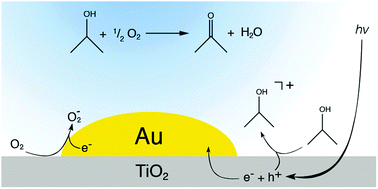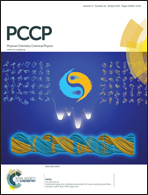On the role of gold nanoparticles in the selective photooxidation of 2-propanol over Au/TiO2†
Abstract
The gas-phase photooxidation of 2-propanol over Au/TiO2 and TiO2 was studied by infrared spectroscopy and online mass spectrometry to gain insight into the mechanism and the role of gold. The presence of O2 was found to be essential for the formation of acetone under UV irradiation at room temperature. In the presence of gold nanoparticles the rate of acetone formation was increased compared to pure TiO2. Baseline bending in the ATR-IR spectra was used as a tool to monitor the accumulation of excess electrons. Electron accumulation was absent in the presence of gold and O2 suggesting that the gold nanoparticles act as co-catalysts enhancing the rate of electron transfer from TiO2 to adsorbed O2 species.

- This article is part of the themed collection: Bunsentagung 2015: Solvation Science

 Please wait while we load your content...
Please wait while we load your content...